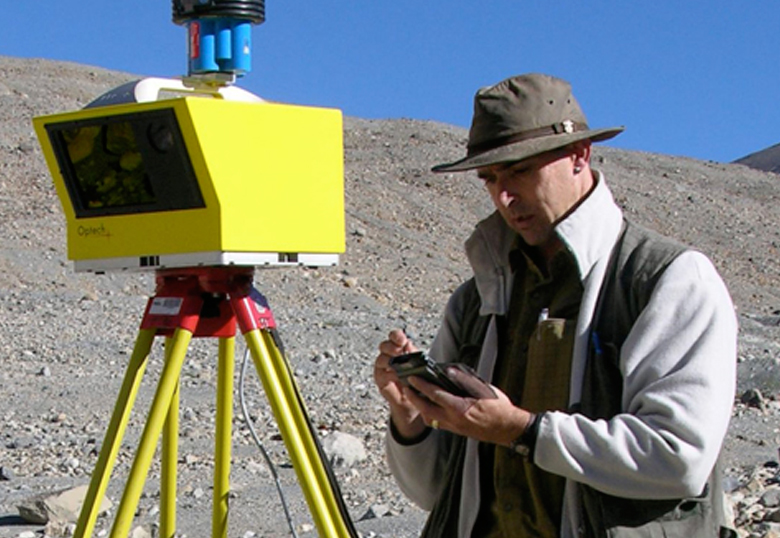From below the earth’s surface to the farthest reaches of the universe, University of Lethbridge researchers are embarking on a pair of significant study projects thanks to research infrastructure support from the Canada Foundation for Innovation (CFI).
On Wednesday, CFI announced a $63-million investment in support of cutting-edge research equipment, laboratories and tools through the John R. Evans Leaders Fund and the Infrastructure Operating Fund. A total of 250 facilities in 37 universities across Canada will receive funding.
For the U of L, it translates into nearly $350,000 in CFI infrastructure support. It will allow Drs. Christopher Hopkinson and Locke Spencer, and their colleagues, the opportunity to pursue imaging studies both on the ground and deep into space.

“The tremendous impact that Drs. Spencer and Hopkinson make in their respective fields will only be enhanced by this important investment,” says the University’s Vice-President (Research) Dr. Dan Weeks. “The University of Lethbridge has increased its research capacity through the attraction of world-leading talent such as these two faculty members and these CFI funds will help ensure the full potential of their research programs is realized.”
The funded projects are as follows:
An Integrated System for High Resolution Terradynamic 3D Imaging
Principal Investigator– Dr. Christopher Hopkinson
Co-applicants– Dr. Laura Chasmer and Dr. Hester Jiskoot
Hopkinson, the Campus Alberta Innovates Program (CAIP) Chair in Terrestrial Ecosystems Remote Sensing, is leading a study that will look at a range of geosciences research questions related to seasonal and long-term environmental changes.
The CFI support of $233,670 will assist in creating a suite of field-based sensors that will support 3D monitoring of environmental processes at plot to landscape scales.
“Our understanding of earth surface/vegetation processes and feedbacks are often limited by an inability to simultaneously observe causes and effects both above and below the ground surface,” says Hopkinson. “This unique integrated advanced-resolution terradynamic monitoring system (ARTeMiS) will be deployed to map and quantify 3D surface and sub-surface features and rates of change. From forest growth to mountain snowpacks to wetland regeneration, ARTeMiS will help characterize both natural and modified ecosystem dynamics.”
The work is significant in that it focuses on issues related to climate change impacts, natural resource management, human disturbance and land reclamation in boreal, alpine, montane and floodplain ecosystems.
Imaging the Universe in the Far-Infrared
Principal Investigator– Dr. Locke Spencer
Spencer (MSc ’05, PhD ’09), a Tier II Canada Research Chair in Experimental Astrophysics, in collaboration with an international team working on related research, is leading an instrumentation project that will improve experimental astrophysics observations in the Far-Infrared (FIR) spectral region, thereby helping us to better understand the formation and evolution of stars, galaxies and the universe as a whole.
“Within Canada, the need to increase support for laboratory-based experimental astrophysics has been identified as a top priority,” says Spencer, who just recently returned to the U of L through the Canada Research Chairs program. “Over half of the energy emitted by the universe appears in the relatively unexplored Far-Infrared spectral region. With the help of this funding, instrumentation will be developed to advance the technologies and techniques needed by future space instruments exploring the Far-Infrared. Many of the current open questions in astrophysics are waiting on better observations in this region.”
The CFI support of $115,200 will allow Spencer to develop a hybrid instrument combining a Fourier transform spectrometer with a spatial interferometer.
While the equipment will initially be developed in a lab, the overall goal of the program is to enhance observations from space-based telescopes. It will also support the University’s continued emergence as a key contributor to astronomy research on both the national and international stage.
“This investment, in parallel to current Canadian efforts in the FIR, presents a ground floor opportunity for Canada to become a key partner in future-generation ground and space-based FIR astronomy observatories,” adds Spencer.
By funding projects such as those initiated by Drs. Hopkinson and Spencer, CFI is helping to ensure that Canada remains a world leader in terms of research and innovation.
“Canadian institutions benefit from investments in research infrastructure which provide the tools needed to be at the forefront of innovation,” says Dr. Gilles Patry, president and CEO of CFI. “The research conducted in these labs and facilities will also train a new generation of researchers which will help Canada maintain its position as a global economic leader.”
